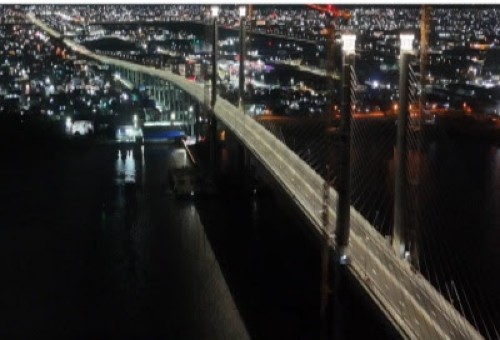Guyana Commissions Multi-Million-Dollar Bridge Built With Chinese Funding
GEORGETOWN, Guyana – Guyana on Sunday evening commissioned the Chinese funded US$262 million dollar Bharrat Jagdeo Demerara River Bridge, with President Irfaan Ali saying it signals the dawn of a new era of transformation.
 Guyana commissions The ‘Bharrat Jagdeo Demerara River Bridge’ Ali justified his decision to name the new east-west river corridor after Jagdeo, who became president of this Caribbean Community (CARICOM) country in 1999 when the then head of state, Janet Jagan stepped down for health reasons.“Today, on behalf of a grateful people, I’m pleased to dedicate this bridge in the name of Bharrat Jagdeo. From this day forward, it shall be called the Bharrat Jagdeo Demerara River Bridge, because great men deserve recognition, because visionaries deserve legacies,” President Ali said as he announced the re-naming of the Demerara River Bridge after his Vice President Bharrat Jagdeo.
Guyana commissions The ‘Bharrat Jagdeo Demerara River Bridge’ Ali justified his decision to name the new east-west river corridor after Jagdeo, who became president of this Caribbean Community (CARICOM) country in 1999 when the then head of state, Janet Jagan stepped down for health reasons.“Today, on behalf of a grateful people, I’m pleased to dedicate this bridge in the name of Bharrat Jagdeo. From this day forward, it shall be called the Bharrat Jagdeo Demerara River Bridge, because great men deserve recognition, because visionaries deserve legacies,” President Ali said as he announced the re-naming of the Demerara River Bridge after his Vice President Bharrat Jagdeo.
Jagdeo, a former finance minister was elected to the position on two occasions with Ali saying “I want to recognise a man that has dedicated his life to the equipment of this country, a man who has been an advisor, an architect and an anchor in our development today, I want to pay tribute to a giant of our local politics and economy”.
Amid much pomp and fanfare, President Ali emphasised the value of the new bridge.
He said that for many thousands of commuter, who travel daily, it would now mean easy, uninterrupted travelling, eliminating the long hours of waiting to cross the floating structure.
He said also the new bridge would spur economic activity on both sides of the river and it is expected that new factories, logistics centres, and corridors of development will rise on both sides of the river because of the ease of travel now facilitated.
“Infrastructure is also a statement; it is a signal to the world that a nation is ready
“This bridge signals that Guyana is ready, ready to industrialise, ready to modernise, and ready to claim its space in the 21st century of the world’s economy,” President Ali said.
The new multi-million dollar structure connects Regions Three and Four, replacing the old floating structure. It has four lanes and will operate 24 hours daily, unlike its predecessor, which was intermittently closed to allow ships to pass through.
“This bridge is financed by the deliberate reinvestment of our national resources. Oil revenues, wisely managed, are being converted into structures like this project that deliver benefits to all Guyanese. This bridge is proof that our resources are not squandered but reinvested into the future of our country,” Ali told the ceremony.
China’s Ambassador to Guyana, Yang Yang, sai the bridge symbolises the commitment of Guyana and China to the Belt and Road Initiative.
“Undoubtedly, this project is not only a bridge of steel and stone, but also a bridge of friendship between China and Guyana, a milestone in the high-quality Belt and Road cooperation we are building together,” she told the ceremony.
The diplomat said that within the framework of the Belt and Road Initiative, Guyana and China’s “shared goal is to realise the people’s aspirations for common development and a better life” and that is the responsibility embraced by Chinese enterprises, and it is also the calling of China as a responsible major country.
The bridge was built by China Railway Construction Corporation Limited and it is projected to last 100 years.
Launched in 2013, the Belt and Road Initiative is a centerpiece of China’s foreign policy that envisages massive sophisticated infrastructure and other forms of connectivity.
Public Works Minister Juan Edghill said that at every stage of construction adhered to international best practices; the design was executed in compliance with AASHTO( American Association of State Highway and Transportation Officials ) specifications, materials were tested in accordance with ASTM ( American Society for Testing and Materials) standards, and all processes were monitored under ISO (International Standards Organisation) -certified benchmarks.
He used the opportunity of the commissioning ceremony to reiterate that the total of 2,798 meters (1.7 miles) structure is safe as beneath the surface lies an extraordinary foundation of 658 piles driven deep into the riverbed.
He said that the main towers, each anchored by approximately 76 enormous piles, measure nearly eight feet in diameter and are driven 400 feet deep, making them among the strongest structural foundations ever constructed in Guyana’s history.
“The New Demerara River Bridge is a modern, four-lane, high-span, cable-stayed structure designed to accommodate both vehicular and pedestrian traffic with the highest standards of safety and efficiency,” Edghill said, adding that the bridge deck is suspended by 136 high-tension cable stays, while the approach sections required 472 precast concrete girders, assembled with precision and strength.
He reiterated that the bridge’s 50-meter fixed high-span eliminates the need for bridge openings for vessel traffic, facilitating continuous vehicular flow and ensuring navigational clearance for vessels up to the Handymax class
Construction of the new Demerara River Bridge began in December 22, 2022


